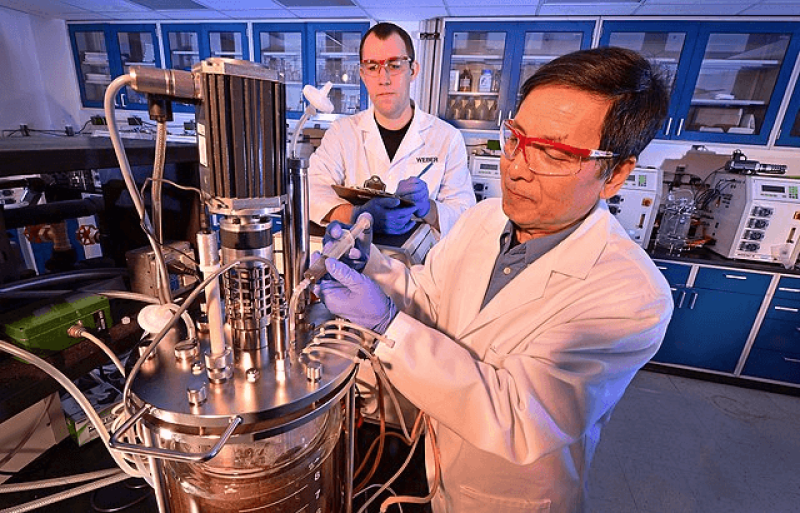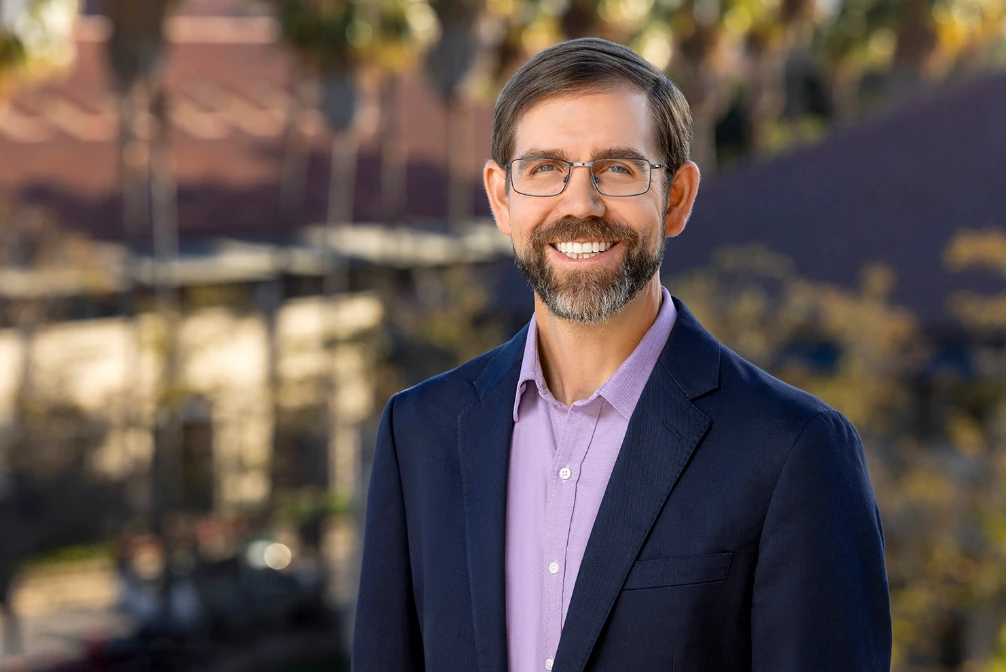How synthetic biology is producing greener chemicals, climate-resilient agriculture and repurposing food waste
How synthetic biology is producing greener chemicals, climate-resilient agriculture and repurposing food waste


“Synthetic biology advances our ability to engineer living systems to address some of the world’s biggest sustainability challenges, allowing us to rethink how we meet human needs on a planetary scale,” said Michael C. Jewett, professor of bioengineering in the Schools of Engineering and Medicine.
In this Q&A, Jewett explains a bit of background about this field and exciting projects already in the works to enable new solutions for planetary health.

What is synthetic biology?
Synthetic biology is a field that uses engineering principles to advance our ability to build with biology. Similar to how software developers write code to instruct computers, synthetic biologists write DNA to guide biological systems in performing specific tasks. What’s so cool is that, unlike computer programs, biology is not just about bits (i.e., information), it’s about bits and atoms … and you can build stuff with atoms. We can now engineer biological systems to address a wide range of needs by composing or building biological systems – from compostable materials to cellular therapies to the future of food.
What’s an example of a synthetic biology innovation with a positive environmental impact?
One example is transforming atmospheric carbon into valuable products. Most of the things around us, from our shoes, polyester t-shirts, and toothbrushes, to the paint on the walls, are made from carbon-based chemicals derived from fossil fuels, which release CO₂ into the atmosphere when made. If we can teach microbes to capture atmospheric carbon and turn it into valuable materials, we can reduce our dependence on fossil fuels.
In collaboration with Lanzatech, my lab learned how to engineer a bacterium called Clostridium to consume carbon dioxide and produce sustainable chemicals. (Full disclosure: I’m on the scientific advisory board of Lanzatech.) We engineer these bacteria to produce chemicals used in everything from disinfectants to jet fuels.
How does this process work?
Think of it like giving a video game character new superpowers. We engineer Clostridium by introducing genes that allow the bacteria to have new abilities, such as producing useful chemicals. As these microbes grow, they consume above-ground carbon and recycle it into chemicals like acetone or isopropanol. Unlike traditional petroleum-based processes that emit CO₂, our engineered microbes lock CO₂ into the product itself. For every kilogram of product made, there is the potential for up to 1.5 kilograms of CO₂ to be removed from the atmosphere. The base organism used is found naturally in various environments and is generally considered safe, like conventional yeast.
What other ways can we engineer biology to address sustainability challenges?
Synthetic biology holds promise to address some of the most pressing sustainability challenges across multiple fields.
- Chemical manufacturing often relies on reactions that require toxic chemicals and a lot of energy. My lab is advancing green chemistry by exploring ways to engineer enzymes capable of catalyzing chemical reactions under milder conditions, reducing energy consumption and the need for toxic solvents, and making industrial processes more environmentally friendly and sustainable.
- Vayu Hill-Maini, an assistant professor of bioengineering, uses synthetic biology to engineer microorganisms to convert waste products into protein-rich foods. This creates new solutions for global food security in areas with limited food resources. This work could revolutionize how we think about food production, turning what would otherwise be discarded into a valuable resource.
- Jenn Brophy, an assistant professor of bioengineering, uses synthetic biology for sustainable agriculture. Jenn is engineering plants to withstand extreme environmental conditions, such as severe drought and heat, which are becoming more frequent as global temperatures continue to rise. She does this by developing synthetic genetic circuits that reprogram plant growth and create more resilient crops.
- Professors Chris Francis and Soichi Wakatsuki are working on nitrification in agricultural soils. We currently depend on nitrogen-based fertilizers to increase agricultural yields to feed the world, but that nitrogen is also consumed by microorganisms. That means less efficient crop production and increased greenhouse gas emissions. Chris and Soichi are working to produce active ammonia monooxygenase enzymes and improved nitrification inhibitors to control this microbial process. (Chris is a professor of Earth systems science and of oceans, and Soichi is a professor of photon science and of structural biology.)
What synthetic biology application in sustainability are you most excited about?
I’m excited about leveraging biology to accelerate carbon capture on a massive scale. Beyond engineered microbes, my lab is also exploring natural enzymes, like carbonic anhydrase, that efficiently convert CO₂ into stable carbonates (like rocks). The challenge is to make these enzymes stable and efficient enough for large-scale carbon removal. If we can succeed, this could remove CO₂ from the atmosphere thousands of times faster than natural processes.
Combining machine learning with synthetic biology also excites me. We can use machine learning to accelerate the design of proteins with specific functions. For example, we are developing enzymes that will change how we make sustainable chemicals.
Helen Dang is a Science Program Manager at Stanford. Follow Helen on LinkedIn

 | Videos | More... |

Video: Nuclear energy will destroy us? Global warming is an existential threat? Chemicals are massacring bees? Donate to the Green Industrial Complex!
 | Bees & Pollinators | More... |

GLP podcast: Science journalism is a mess. Here’s how to fix it

Mosquito massacre: Can we safely tackle malaria with a CRISPR gene drive?

Are we facing an ‘Insect Apocalypse’ caused by ‘intensive, industrial’ farming and agricultural chemicals? The media say yes; Science says ‘no’
 | Infographics | More... |

Infographic: Global regulatory and health research agencies on whether glyphosate causes cancer
 | GMO FAQs | More... |

Why is there controversy over GMO foods but not GMO drugs?

How are GMOs labeled around the world?

How does genetic engineering differ from conventional breeding?
 | GLP Profiles | More... |

Alex Jones: Right-wing conspiracy theorist stokes fear of GMOs, pesticides to sell ‘health supplements’




 A single high dose of LSD can ease anxiety and depression for months
A single high dose of LSD can ease anxiety and depression for months From plastic coasters to human hearts: Inside the race to print the human body
From plastic coasters to human hearts: Inside the race to print the human body CRISPR pork: U.S. approves first gene-edited pigs for consumption
CRISPR pork: U.S. approves first gene-edited pigs for consumption ‘SuperAgers’: Why some people have the brains and memory capacity of people decades younger
‘SuperAgers’: Why some people have the brains and memory capacity of people decades younger  Baby food panic, brought to you by trial lawyers hoping to prosecute by press release
Baby food panic, brought to you by trial lawyers hoping to prosecute by press release From ‘Frankenfood’ to superfood: Can the purple tomato overcome GMO myths to win over consumers?
From ‘Frankenfood’ to superfood: Can the purple tomato overcome GMO myths to win over consumers? Viewpoint: Life and death decisions: RFK, Jr.’s shady FDA “expert panels” operate in secret with no transcripts or conflict of interest reviews
Viewpoint: Life and death decisions: RFK, Jr.’s shady FDA “expert panels” operate in secret with no transcripts or conflict of interest reviews When farmers deny science: The hypocrisy hurting agriculture’s credibility
When farmers deny science: The hypocrisy hurting agriculture’s credibility
